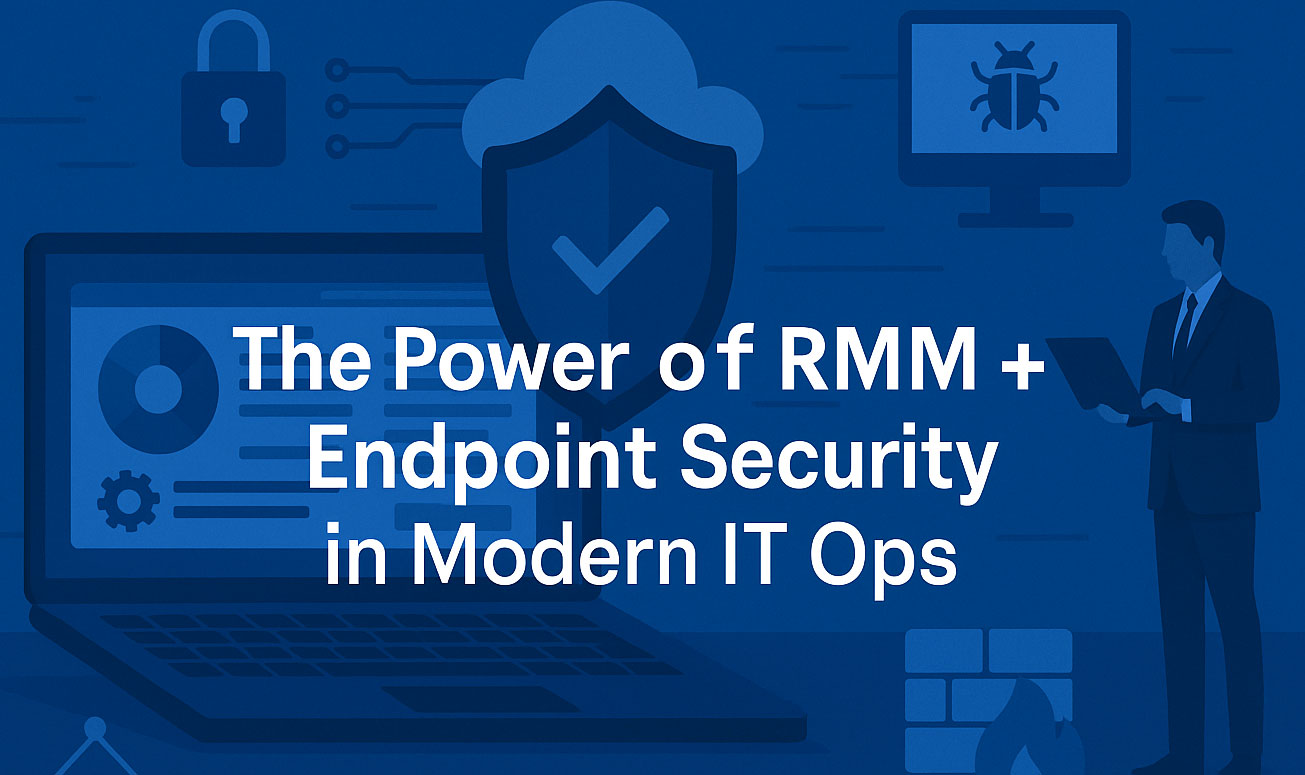No products in the cart.
 Unifying IT and Security
Unifying IT and Security
IT operations and cybersecurity are critical to business continuity. They often operate in separate silos—each with its own tools, workflows, and priorities. This separation causes inefficiencies, delayed responses, and increased risk exposure.
Remote Monitoring and Management (RMM) keeps systems running optimally. Endpoint Security protects against cyber threats. Each plays a vital role. Together, they create a cohesive ecosystem that improves visibility, responsiveness, and IT resilience. This convergence has become essential for organizations facing a rapidly changing threat landscape.
What Is RMM? The IT Control Center
RMM provides centralized control and real-time system visibility. IT teams manage infrastructure remotely and address issues proactively.
Core RMM capabilities include:
Remote endpoint access for diagnostics
Automated patching to close security gaps
Performance monitoring to prevent disruptions
Script automation to streamline routine tasks
RMM allows teams to manage thousands of devices from a single dashboard. It reduces downtime, boosts productivity, and scales IT support efficiently.
Endpoint Security: Defense at the Edge
RMM focuses on system uptime and performance. Endpoint Security protects devices from cyber threats. Every laptop, server, and mobile device is a potential entry point for attackers—making endpoint protection essential.
Modern Endpoint Security includes:
Antivirus and malware protection
Endpoint Detection and Response (EDR)
Firewall and intrusion prevention systems
Policy controls for managing user behavior
Endpoint solutions must detect threats and respond automatically. This reduces risk and exposure as attacks become more sophisticated.
Why Integration Is Critical
RMM and Endpoint Security operating independently create blind spots. An RMM may detect unusual CPU usage. Endpoint Security may identify a potential threat. Without integration, alerts remain isolated.
Combining the two allows for:
Unified visibility across IT operations and security
Faster response through automated workflows
Reduced tool fatigue from duplicate alerts
Stronger collaboration between teams
They offer a “single source of truth” for system health and security status.
Synergy in Action: Unified IT Armor
An integrated RMM-Endpoint Security solution provides holistic protection across the infrastructure. The synergy enables:
- Consolidated dashboards to monitor performance and threats
- Automated remediation, where security events trigger RMM actions
- Enhanced compliance reporting from a centralized view
- Correlated alerts accelerate and simplify root cause identification.
A defense system where operations and security work as one.
Faster Incident Response
Speed is critical in handling security breaches. Integrated platforms isolate infected devices, roll back malicious changes using system snapshots, and deploy emergency patches automatically.
Benefits include:
Containment of threats
Reduced downtime and data loss
24/7 defense without manual intervention
Proactive automation neutralizes threats before they spread.
Efficiency at Scale
Managing hybrid environments with remote workers, cloud platforms, and personal devices (BYOD) adds complexity. A unified approach simplifies this:
- Reduces tool clutter by merging operations and security
- Standardizes policies across varied devices and networks
- Supports hybrid and remote workforces with consistent protection
- Improves visibility into both performance and risk metrics
This leads to lower overhead and faster IT service delivery.
Compliance and Audit Readiness
Regulations like HIPAA, GDPR, and ISO 27001 require strong controls, clear documentation, and continuous oversight.
An integrated setup provides:
- Centralized logging and reporting
- Automated policy enforcement
- Real-time compliance alerts
- Streamlined audit preparation
Audit readiness becomes a continuous process, not a rushed, last-minute task.
Overcoming Integration Challenges
Integration brings challenges. These include:
- Alert fatigue from redundant or irrelevant notifications
- Compatibility issues between legacy tools
- Gaps in team collaboration between IT ops and security units
To mitigate these:
- Choose platforms built for interoperability
- Set meaningful alert thresholds
- Align teams with shared KPIs and regular communication
Integration is both a technical and cultural effort.
Industry Use Cases
Organizations across industries recognize the benefits:
- Healthcare: Ransomware attacks prevented through automated endpoint isolation and patching
- Finance: Real-time fraud detection linked to device anomalies and response playbooks
- Education: Centralized control of campus-wide devices with minimal IT staff involvement
The examples highlight the operational value of unifying RMM with security.
What’s Next: AI and Predictive Defense
The future of RMM and Endpoint Security centers on automation and intelligence. Artificial intelligence drives a paradigm shift, introducing functionalities like:
Predictive threat detection before breaches occur
- Self-healing systems with autonomous remediation
- Behavioral analytics to detect subtle anomalies
- Dynamic policy enforcement based on risk levels
These innovations transform IT from reactive to predictive, reducing the burden on human teams.
Conclusion: Stronger Together
The convergence of RMM and Endpoint Security creates a strategic foundation for secure, efficient, and scalable IT operations. Bridging the gap between system health and threat defense gives organizations full-spectrum control over their infrastructure.
This integrated approach defines the future. Early adopters are better equipped to defend, adapt, and thrive in an evolving digital world.
Check out our newest blog entry (How actsupport Optimizes SolusVM Server Operations)
Subscribe to get free blog content to your Inbox
The Hidden Cost of Poor Hosting Support



 Unifying IT and Security
Unifying IT and Security